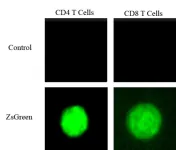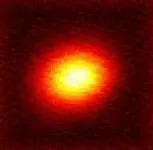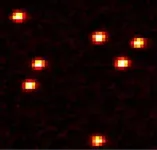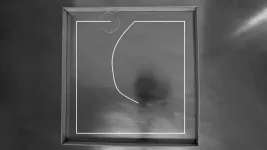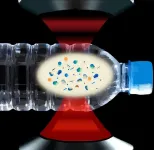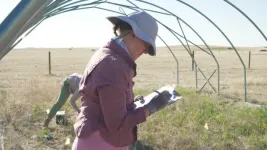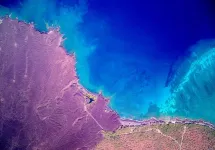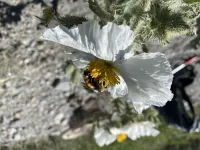(Press-News.org) AMHERST, Mass. – In a first-of-its-kind research breakthrough, a team of scientists at the University of Massachusetts Amherst has analyzed and described what they call the “mosquito effect,” which sheds light on how certain pathogens, such as cancerous tumor cells, can outwit the body’s immune system.
Just as mosquitoes ingest their host’s blood, the immune system’s T cells incorporate cytoplasmic material from tumors into their own cytoplasm. While it has long been known that many kinds of cells can transfer cellular material from one to another, the transfer of the cytoplasm has never been observed in T cells. Subsequent single-cell RNA (scRNA) sequencing shows that cytoplasm from tumor cells alters the machinery responsible for protein coding in the host T cell. The research, reported recently in the journal Frontiers in Immunology, is a major step forward in understanding how tumors can successfully evade the immune system, and thus a step toward more effective treatments.
One of the great mysteries in medicine is how certain pathogens can suppress the immune system in order to spread wildly. There are many different parts to the immune system, but among the most important are T cells, which identify and attack pathogens, and the T regulatory cells, which tell the T cells when it’s safe to call off the attack, limiting collateral damage to the body.
And yet, cancerous tumor cells have figured out how to short-circuit the immune system, with often catastrophic results for healthy tissues. How, exactly, tumor cells do this is unknown, but, says Leonid Pobezinsky, associate professor of veterinary and animal sciences at UMass Amherst and the paper’s senior author, “we’ve observed for the very first time that T cells and T regulatory cells suck up a bit of tumor cytoplasm and integrate it into their own.”
To make the discovery, Pobezinsky and his team, including first author Kaito Hioki, graduate student in veterinary and animal science at UMass Amherst, and Elena Pobezinskaya, research assistant professor also in veterinary and animal sciences at UMass and co-senior author of the paper, engineered tumor cells to produce an ultrabright fluorescent protein called ZsGreen. They then introduced the green-glowing tumor cells into a mouse model. After eight days, the model’s tumor-infiltrating immune cells were gathered and analyzed using state-of-the-art equipment in the Flow Cytometry lab at UMass Amherst’s Institute for Applied Life Sciences.
“What we saw was striking,” says Pobezinskaya. “The T cells were glowing and uniform green, which tells us that that the tumor’s cytoplasm had been distributed widely throughout the T cell.”
Even more surprising was to see the T regulatory cells light up as well. And the team found that the cells glowing the brightest were the ones most exhausted from their fight against the tumor. Finally, the team determined that the transference of cellular material requires the cells of the tumor and the immune system to come into physical contact with each other.
“We know that tumor cells use multiple ways to suppress the immune system,” says Hioki. “We also now know that T cells incorporate some of the tumor in their own cytoplasm, and that the least aggressive immune cells have the most tumor cytoplasm in them. What we don’t know is why. Are the T cells looking for food? Are they trying to survey and adapt to their new environment by taking in parts of other cells? And finally, is the tumor hijacking this mechanism to shut down T cells?”
These questions are all next steps for the authors, whose work was supported by the National Institutes for Health and the National Research Service Award.
Contacts: Elena Pobezinskaya, pobezinskaya@umass.edu
Daegan Miller, drmiller@umass.edu
END
Researchers have developed a new soft robot design that engages in three simultaneous behaviors: rolling forward, spinning like a record,and following a path that orbits around a central point. The device, which operates without human or computer control, holds promise for developing soft robotic devices that can be used to navigate and map unknown environments.
The new soft robots are called twisted ringbots. They are made of ribbon-like liquid crystal elastomers that are twisted – like a rotini ...
In recent years, there has been rising concern that tiny particles known as microplastics are showing up basically everywhere on Earth, from polar ice to soil, drinking water and food. Formed when plastics break down into progressively smaller bits, these particles are being consumed by humans and other creatures, with unknown potential health and ecosystem effects. One big focus of research: bottled water, which has been shown to contain tens of thousands of identifiable fragments in each container.
Now, using newly refined technology, researchers have entered a whole ...
The body’s immune response to Epstein-Barr virus (EBV) may play a role in causing damage in people with multiple sclerosis, according to a new study led by UTHealth Houston.
EBV infection has long been associated with multiple sclerosis, but how the infection might contribute to multiple sclerosis has not been clear. More than 95% of people have been infected with this very common virus; however, it typically remains in its latent stage and doesn’t cause any issues. In some cases, though, the T-cells specific for the EBV infection may cause ...
EMBARGO: THIS CONTENT IS UNDER EMBARGO UNTIL 3 P.M. U.S. EASTERN STANDARD TIME ON JANUARY 8. INTERESTED MEDIA MAY RECIVE A PREVIEW COPY OF THE JOURNAL ARTICLE IN ADVANCE OF THAT DATE OR CONDUCT INTERVIEWS, BUT THE INFORMATION MAY NOT BE PUBLISHED, BROADCAST, OR POSTED ONLINE UNTIL AFTER THE RELEASE WINDOW.
A global study organized and led by Colorado State University scientists shows that the effects of extreme drought – which is expected to increase in frequency with climate change – has been greatly underestimated for grasslands and shrublands.
The findings – published in Proceedings of the National Academy of Sciences – quantify the impact of extreme ...
Researchers at McMaster University have discovered a molecular “barcode” system used by disease-causing bacteria to distinguish between beneficial and toxic molecules.
Published in the Proceedings of the National Academy of Sciences (PNAS), the new study shows that many bacteria can figuratively scan genetic codes to learn which proteins to keep and which proteins to expel into the environment.
According to researchers, those proteins that are expelled are often toxic to human cells, making the ...
Well-managed migration can enable migrants to boost sustainable development, research shows.
Sustainable development means enhancing wellbeing in ways that equitably meet needs of present and future generations.
Migration is often viewed as a threat to this – and to stability and security – while the benefits for migrants and host nations and regions are overlooked.
The new research – a set of studies published in the journal Proceedings of the National Academy of Sciences – shows new policies are needed for managing migration to maximise sustainability, and to minimise involuntary displacement due to conflict or disasters.
The ...
Novel Test Holds Promise for Detecting Parkinson’s Disease Early
Investigators from Brigham and Women’s Hospital and the Wyss Institute are working together to develop a new approach to detect and quantify minute amounts of a biomarker of Parkinson’s disease and related disorders at early stages
The platform has the potential to create early applicable molecular diagnostics, improve clinical trials, and facilitate drug screening
(Boston) — In the development of Parkinson’s ...
When imagining corals, the picture that comes to mind is usually a stationary one: a garden of rock-like structures covering sections of the ocean floor. Reef conservation efforts typically focus on preserving established coral and protecting them from known stressors such as pollution, overfishing and runoff from coastline populations.
However, new research near Miloliʻi in the southwestern part of Hawai’i Island shows that identifying and protecting marine ecosystems, both down-current and up-current of coral reefs, specifically areas where coral larvae are more likely to survive and thrive, is crucial to future coral conservation and restoration efforts—especially ...
FORT COLLINS, Colo., Jan. 8, 2024 — What’s all the buzz about? Most garden enthusiasts know that certain flowers can attract pollinators. New research helps explain why, and also provides more details about how the nutrition found in plant pollen may determine which specific bee communities might favor your garden. On a larger scale, this research may help fight against pollinator declines through better design of rangeland restoration projects.
Scientists at the USDA Forest Service’s ...
The brain is not only the most complex organ of the human body, but also one of the most difficult to study. To understand the roles of different regions of the human brain and how they interact, it is crucial to measure neuronal activity with awake subjects while they perform controlled tasks. However, the most accurate measurement devices are invasive, which greatly limits their use on healthy humans in real-life settings.
To overcome this major obstacle, scientists have come up with ingenious techniques to measure brain activity in safe and ...
